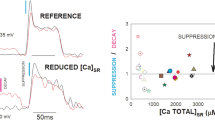Abstract
The rate of release of transmitter quanta, elicited by variable depolarization pulses applied to a nerve terminal by means of a macro-patch-clamp electrode, was measured in muscles of crayfish and frogs. The electrode was perfused with solutions containing different Ca concentrations, Cae. The bath was superfused separately, usually with solutions containing nominally no Cab and elevated Mgb. A fixed depolarization pulse followed the variable test pulse within 7–10 ms, and facilitation, Fc, of release after the fixed pulse was determined as a measure of Ca-inflow during the test pulse. As described before, Fc always showed a peak, Fc, at depolarization amplitudes of the test pulse below the saturation level of release. When Cae was changed, the depolarization levels generating Fc shifted in a negative direction if Cae was lowered, and in a positive direction if Cae was increased. These shifts agreed with the known dependence of the effective membrane potential (controlling e.g. Ca inward current) on Cae which is due to shielding of surface changes by Ca2+ (cf. Hille 1984). Changes of Cab, at constant Cae, did not affect the depolarization dependence of Fc. It is concluded that Ca inflow is not the only factor controlling quantal release, and that at least in depolarizations beyond those eliciting Fc another potential dependent factor increases release while Ca inflow presumably falls.
Similar content being viewed by others
References
Augustine GJ, Charlton MP (1986) Calcium dependence of presynaptic calcium current and post-synaptic response at the squid giant synapse. J Physiol (Lond) 381:619–640
Byerly L, Chase PB, Stimers J (1985) Permeation and interaction of divalent cations in calcium channels of snail neurons. J Gen Physiol 85:491–518
Dudel J (1983) Transmitter release triggered by a local depolarization in motor nerve terminals of the frog: role of calcium entry and of depolarization. Neurosci Lett 41:133–138
Dudel J (1984a) Control of quantal transmitter release at frog's motor nerve terminals. I. Dependence on amplitude and duration of depolarization. Pflügers Arch 402:225–234
Dudel J (1984b) Control of quantal transmitter release at frog's motor nerve terminals. II. Modulation by de- or hyperpolarizing pulses. Pflügers Arch 402:235–243
Dudel J (1986a) Dependence of double-pulse facilitation on amplitude and duration of the depolarization pulses at frog's motor nerve terminals. Pflügers Arch 406:449–457
Dudel J (1986b) Transmitter release from nerve terminals evoked by depolarization pulses contains a short phase of repression. Pflügers Arch 407:134–141
Dudel J (1989a) Nerve terminal depolarization, calcium inflow and transmitter release. In: Sellin LC, Libelius R, Thesleff S (eds) Neuromuscular junction Elsevier, Amsterdam
Dudel J (1989b) Calcium dependence of quantal release triggered by graded depolarization pulses to nerve terminals on crayfish and frog muscle. Pflügers Arch 415:289–298
Dudel J (1989c) Calcium and depolarization dependence of twinpulse facilitation of synaptic release at nerve terminals of crayfish and frog muscle. Pflügers Arch 415:304–309
Dudel J, Parnas I, Parnas H (1983) Neurotransmitter release and its facilitation in crayfish muscle. VI. Release determined by both, intracellular calcium concentration and depolarization of the nerve terminal. Pflügers Arch 399:1–10
Frankenhäuser B, Hodgkin AL (1957) The action of calcium on the electrical properties of squid axons. J Physiol (Lond) 137:218–244
Hille B (1984) Ionic channels of excitable membranes. Sinauer Associates Inc, Sunderland, MA, USA
Kostyuk PG, Mironov SL, Doroshenko PA, Ponomarev VN (1982) Surface charges on the outer side of mollusc neuron membrane. J Membr Biol 70:171–179
Llinás R, Steinberg IZ, Walton K (1981) Relationship between presynaptic calcium current and postsynaptic potential in squid giant synapse. Biophys J 33:323–352
Madden KS, van der Kloot W (1978) Surface charges and the effects of calcium on the frequency of miniature end-plate potentials at the frog neuromuscular junction. J Physiol (Lond) 276:227–232
Parnas H, Segel LA (1981) A theoretical study of calcium entry in nerve terminals, with application to neurotransmitter release. J Theor Biol 91:125–169
Parnas H, Dudel J, Parnas I (1982) Neurotransmitter release and its facilitation in crayfish. I. Saturation kinetics of release, and of entry and removal of calcium. Pflügers Arch 393:1–14
Parnas H, Dudel J, Parnas I (1986) Neurotransmitter release and its facilitation in crayfish. VII. Another voltage dependent process beside Ca entry controls the time course of phasic release. Pflügers Arch 406:121–130
Parnas I, Parnas H, Dudel J (1982) Neurotransmitter release and its facilitation in crayfish. II. Duration of facilitation and removal processes of calcium from the terminal. Pflügers Arch 393:232–236
Parnas I, Parnas H, Dudel J (1986) Neurotransmitter release and its facilitation in crayfish. VIII. Modulation of release by hyperpolarizing pulses. Pflügers Arch 406:131–137
van der Kloot W, Latta R (1983) How elevated extracellular Ca2+ inhibits quantal acetylcholine release at frog neuromuscular junctions in high K+. Pflügers Arch 397:85–89
Zucker RS, Landò L (1986) Mechanism of transmitter release: voltage hypothesis and calcium hypothesis. Science 231:574–579
Author information
Authors and Affiliations
Additional information
Supported by the Deutsche Forschungsgemeinschaft (SFB 220)
Rights and permissions
About this article
Cite this article
Dudel, J. Shifts in the voltage dependence of synaptic release due to changes in the extracellular calcium concentration at nerve terminals on muscle of crayfish and frogs. Pflügers Arch 415, 299–303 (1989). https://doi.org/10.1007/BF00370879
Received:
Revised:
Accepted:
Issue Date:
DOI: https://doi.org/10.1007/BF00370879



